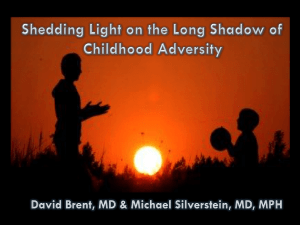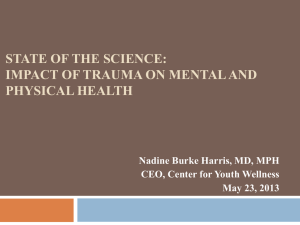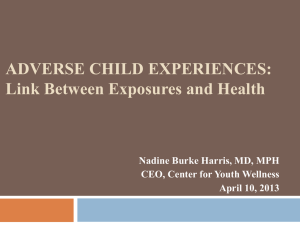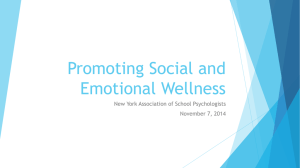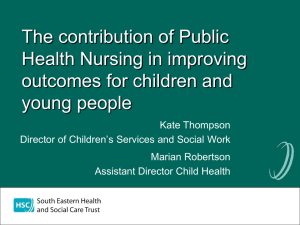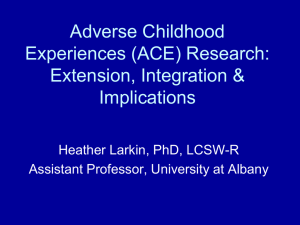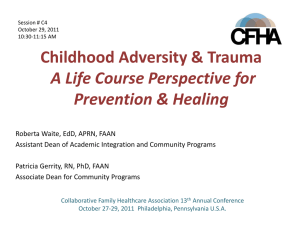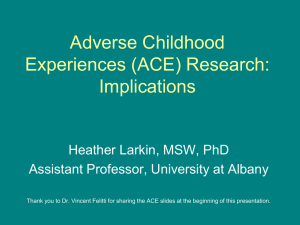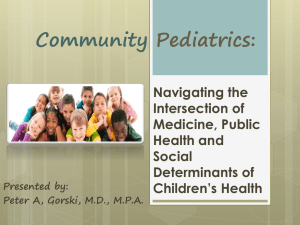PRESENTATION TO OCDEL STAKEHOLDERS final 022013
advertisement
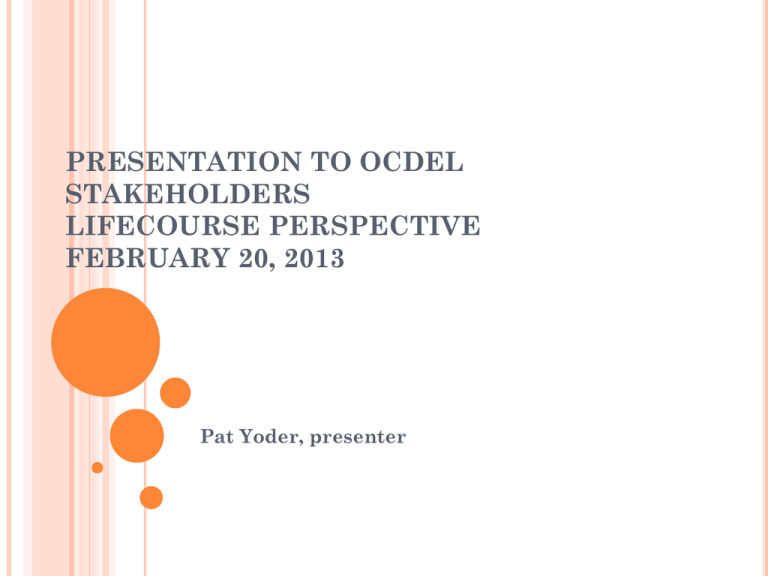
PRESENTATION TO OCDEL STAKEHOLDERS LIFECOURSE PERSPECTIVE FEBRUARY 20, 2013 Pat Yoder, presenter PPP MEMBERS Maternal and Child Health programs Title V- Federal block grant dollars to PA Dept of Health, which makes grants to 10 county and municipal health departments and Healthy Start programs funded directly by DHHS to 7 programs in PA CONCEPTS AND LANGUAGE OCDEL focus on early childhood from an educational perspective MCH professionals focus on early childhood from a maternal/pregnancy/pre-pregnancy perspective POSSIBILITIES We serve the same people Our results are not as good as we’d like Collaboration should help improve our results If we do better, our clients should do better, and there should be opportunities to increase funding SO, LET’S TALK! LIFE COURSE PERSPECTIVE FRAMEWORK The current most promoted concept for thinking about maternal and child health Designed to address the extremely resistant problem of racial disparities in infant mortality IN THE BEGINNING Adverse Childhood Experiences Study Thanks to Dr. Ron Voorhees, M.D., M.P.H., Acting Director, Allegheny County Health Department. Several slides from his presentation on ACE, presented October 26, 2011 to PPP follow. RELATIONSHIP OF CHILDHOOD ABUSE AND HOUSEHOLD DYSFUNCTION TO MANY OF THE LEADING CAUSES OF DEATH IN ADULTS: THE ADVERSE CHILDHOOD EXPERIENCE (ACE) STUDY Vincent J. Felitti, Robert F. Anda, Dale Nordenberg, David F. Williamson, Alison M. Spitz, Valerie Edwards, Mary P. Koss, James S. Marks American Journal of Preventive Medicine, 1998; 14(4) 245-258 ADVERSE CHILDHOOD EXPERIENCES More than 17,000 Kaiser patients were asked to recall their childhood experiences Health conditions in the present were tabulated ACE STUDY - CATEGORIES OF ADVERSE CHILDHOOD EXPERIENCES (ACE) Psychological abuse Physical abuse Sexual abuse Substance abuse in home Mental illness in parent Violence against mother Incarceration of parent KAISER HMO ENROLLEES HAD AT LEAST ONE TYPE OF ADVERSE CHILDHOOD EXPERIENCE 4 Categories: 3 Categories 6.2% 6.9 % 2 Categories 12.5% 0 Categories 49.5% 1 Category 24.9% Data from Felitti, et. al. GROWING UP WITH ADVERSE CHILDHOOD EXPERIENCES INCREASES THE RISK FOR MANY LATER ADVERSE HEALTH CONDITIONS – RANGING FROM SMOKING TO OBESITY TO DEPRESSION AND SUBSTANCE ABUSE. FOUR OR MORE ACES DOUBLE THE RISK FOR BEING A SMOKER Odds Ratio (relative to 0 ACEs) 1.1 1.5 2.0 Number of ACE Categories Data from Felitti, et. al. 2.2 ACES INCREASE RISK FOR CHRONIC BRONCHITIS/EMPHYSEMA Odds Ratio (Relative to 0 categories) 14 12 10 8 6 3.9 4 2 1.6 1.6 1 2 2.2 0 3 Number of ACE Categories Data from Felitti, et. al. >=4 ACES INCREASE THE RISK OF STROKE Odds Ratio (Relative to 0 categories) 14 12 10 8 6 4 2 0.9 0.7 1 2 1.3 2.4 0 3 Number of ACE Categories Data from Felitti, et. al. >=4 ACES INCREASE RISK OF ISCHEMIC HEART DISEASE Odds Ratio (Relative to 0 categories) 14 12 10 8 6 4 2 0.9 0.9 1 2 1.4 2.2 0 3 Number of ACE Categories Data from Felitti, et. al. >=4 ACES INCREASE THE RISK OF CANCER Odds Ratio (Relative to 0 categories) 14 12 10 8 6 4 1.2 1.2 1.0 1.9 1 2 3 >=4 2 0 Number of ACE Categories Data from Felitti, et. al. ACES INCREASE REPORTING OF HAVING AN STD Odds Ratio (Relative to 0 categories) 14 12 10 8 6 4 2 1.4 1.5 1 2 1.9 2.5 3 >=4 0 Number of ACE Categories Data from Felitti, et. al. ACES INCREASE RISK OF HAVING HAD OVER 50 SEXUAL PARTNERS Odds Ratio (Relative to 0 categories) 14 12 10 8 6 4 2 1.7 2.3 3.1 3.2 3 >=4 0 1 2 Number of ACE Categories Data from Felitti, et. al. ACES INCREASE THE RISK FOR DEPRESSION ALMOST FIVE TIMES Odds Ratio (relative to 0 ACEs) 4.6 1.5 2.4 2.6 Number of ACE Categories Data from Felitti, et. al. FOUR ACES INCREASE THE RISK FOR USING ILLICIT DRUGS 4.7 TIMES; EVEN ONE ALMOST DOUBLES THE RISK: Odds Ratio (relative to 0 ACEs) 3.6 2.9 1.7 Number of ACE Categories Data from Felitti, et. al. 4.7 ACES INCREASE THE RISK FOR ALCOHOLISM Odds Ratio (relative to 0 ACEs) 7.4 4.9 4.0 2.0 Number of ACE Categories Data from Felitti, et. al. ACES INCREASE THE RISK FOR SUICIDE ATTEMPT OVER 12 TIMES: 12.2 Odds Ratio (relative to 0 ACEs) 6.6 3.0 1.8 Number of ACE Categories Data from Felitti, et. al. SOCIOECONOMIC IMPACT OF CHILD ABUSE AND NEGLECT David Zielinski (Duke University) estimated that almost 20% of unemployed adults report abuse or neglect as child Adult victims of maltreatment: have less education have more physical and mental health problems that interfere with their work are twice as likely to be below federal poverty level are twice as likely to be on Medicaid DISPARITIES IN INFANT MORTALITY Not so long ago, maternal and child health workers believed that just getting women in for at least ONE prenatal visit would make a difference in the rates of infant mortality The science has changed; our understanding has deepened Focus has shifted to racial disparities and why they are so persistent WHY? Many studies have shown that the factors that might explain the racial disparities, don’t! Genetics Behavior Prenatal Care SES Stress Infection MULTIPLE RISK FACTORS Explain less than 10% of the variation in low birth weights between white and AfricanAmerican babies EARLY PROGRAMMING Emphasis on importance of sensitive developmental periods in utero or early life during which future reproductive potential becomes programmed KNOWLEDGE IS INCREASING In the last 20 years, David Barker, MD, PhD, FRS, studied what happens to a low birth weight baby Health consequences in adult life, such as heart disease and diabetes Mother’s consistent prenatal stress affects her hormones, which in turn, affects the baby’s brain development Epigenetics =another continuing aspect of study (trust me!!) STILL MORE COMPLEXITY Cumulative pathways All that happens throughout the life of the mother, and her mother (not to mention what we’re learning about dads!) THESE ARE NOT MUTUALLY EXCLUSIVE! Early programming and cumulative pathways affect the life course over generations WHAT TO DO? 12 POINT PROGRAM Improving Health care Services Provide interconception care to women with prior adverse pregnancy outcomes Increase access to preconception care for women Improve the quality of prenatal care Expand health care access over the life course STRENGTHENING FAMILIES AND COMMUNITIES Strengthen father involvement in families Parental resilience Enhance service coordination and systems integration Create reproductive social capital in communities Invest in community building and urban renewal ADDRESSING SOCIAL AND ECONOMIC INEQUITIES Close the education gap Knowledge of parenting and child development Reduce poverty Support working mothers and families Undo racism OPPORTUNITIES ABOUND! Break down barriers Talk and work with one another Recognize commonalities Keep hope alive REFERENCES Barker, David, http://www.thebarkertheory.org contains complete references Lu, Michael and Neil Halfon, “Racial and Ethnic Disparities in Birth Outcomes: A Life-Course Perspective,” Maternal and Child Health Journal, Vol. 7, No. 1, March 2003” Lu, Michael, “Strong Roots Healthy Fruit: Transforming Generations through the Life Course Perspective,” June 29, 2010, Philadelphia Department of Public Health, Division of Maternal and Child Health, DVD presentation Ronald E. Voorhees, MD, MPH, “Improving Health: First Things First,” PPP, October 26, 2011, Power Point Presentation
